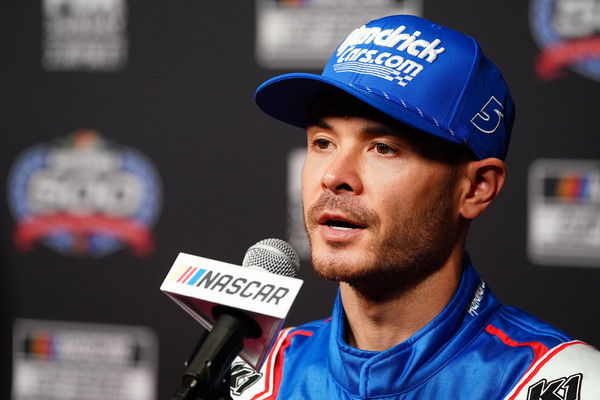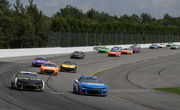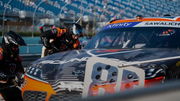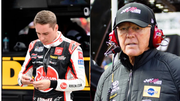
USA Today via Reuters
Feb 14, 2024; Daytona Beach, Florida, USA; NASCAR Cup Series driver Kyle Larson (5) speaks with reporters during media day at Daytona International Speedway. Mandatory Credit: John David Mercer-USA TODAY Sports

USA Today via Reuters
Feb 14, 2024; Daytona Beach, Florida, USA; NASCAR Cup Series driver Kyle Larson (5) speaks with reporters during media day at Daytona International Speedway. Mandatory Credit: John David Mercer-USA TODAY Sports
Watkins Glen shook things up in January by tweaking its layout—adding rumble strips in turn 1 and ditching some inside the Bus Stop chicane on the backstretch. The addition of a “turtle” or “sausage” curb at the bus stop entry has sparked a hefty debate among drivers from NASCAR and IMSA.
Recently, Connor Zilisch from Trackhouse Racing wasn’t thrilled, sharing his thoughts with a simple, “If it ain’t broke, don’t fix it☹️.“ Parker Kligerman chimed in too, with a worried, “Oh no… @WGI what have you done?!” Other ARCA and Xfinity drivers also voiced their discontent with the changes. However, on the flip side, Kyle Larson from HMS seems all for it, even posting recent data explaining his support for the new curbing at Watkins Glen.
ADVERTISEMENT
Article continues below this ad
Kyle Larson supports the NASCAR decision and backs it up with personal data
On social media, Larson shared some compelling data from a mouthpiece he wore last year, which measures g-forces experienced during races—especially in crashes. His post included charts showing just how intense these forces can be when hitting the corners 80–90 times a day. He noted, “My mouthpiece data from last year through the bus stop. Something needed to be done. What was there before was not safe for the brain. Hopefully, this is better.”
What is indicated is that previously, going through the bus stop and over the curbs, he’d experience forces nearly reaching 12 G’s, sometimes even spiking up to 18 G’s. To put that in perspective, drivers often feel forces of 50 to 60 G’s in severe head-on crashes with the wall, which happen once in a while. But imagine hitting those curbs repeatedly during a race, up to 90 times, and peaking at 18 G’s; it really starts to add up. No wonder Kyle Larson is a proponent of the new changes.
NASCAR has also confirmed that the tweaks to the bus stop curbing at Watkins Glen were largely driven by data from mouthpieces used by Kyle Larson and others last season. A spokesperson told TobyChristie.com, “Yes, the mouthpiece data from Larson (and all those who wore it) necessitated this move. We saw that an abnormally large number of ‘incidents’ were triggered in this area. Credit to NASCAR safety team and the drivers who participated in this mouthpiece program. It was an initiative started to continue improving on safety, and this is one of the results.”
My mouth piece data from last year through the bus stop. Something needed to be done. What was there before was not safe for the brain. Hopefully this is better. pic.twitter.com/AjpN7unIsb
— Kyle Larson (@KyleLarsonRacin) April 25, 2024
The new curbs will prevent drivers from slicing too close to the inside wall, forcing them to take a wider, slower approach at the first corner of the complex. This not only transforms the bus stop into more of a chicane but might also turn it into a hot spot for overtaking. However, it introduces a new hazard to those turtle curbs, possibly sending cars flying.
ADVERTISEMENT
Article continues below this ad
Trending
Why might sausage curbs be a bad idea?
IMSA BMW factory prototype driver Connor de Philippi pointed out the risks, recalling a scenario where a car hit one of these curbs at a weird angle and got launched into the air, flipping upside down in a 2022 race at Monza. He mentioned the potential dangers of “broken backs or cars upside down,” highlighting the serious implications of such track features.
On paper, sausage curbs sound good—they prevent drivers from cutting corners by making the edges of the track punishable without needing massive gravel traps. But in reality, they can act like launching pads for any car that hits them wrong. They act more like ramps, sending cars flying off at dangerous angles, which really cranks up the risk factor.
ADVERTISEMENT
Article continues below this ad
Need proof? Back in 2022, Six Hours of Monza Aston Martin driver Henrique Chaves spun out before a corner was lined because of these sausage curbs. Instead of skimming over them and using the runoff to decelerate safely, his #33 TF Sport Aston Martin got flung into the air, did a spin and crashed down roof-first at a frightening speed.
It’s ironic—a safety feature that ends up making the track way more treacherous. Monza has had its share of drama with these curbs over the years, flinging Formula 3 cars like Alex Peroni’s right into the air when they veer off on a corner exit. After incidents like these, you’ve got to hope that Watkins Glen will rethink its curb strategy.
ADVERTISEMENT
ADVERTISEMENT
ADVERTISEMENT
ADVERTISEMENT






